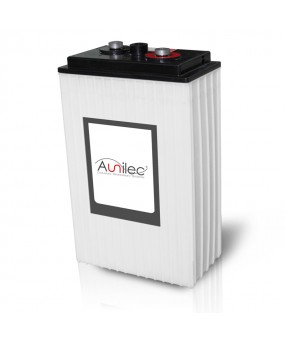
Batteries
3 types of batteries : The AGM battery series are designed with advanced technology, super heavy duty grid, high performance plates and electrolyte. The AGM battery series have long and reliable standby life and high consistency for better performance in series use. The GEL batteries can avoid corrosion and stratification. The special separator can properly prevent short-circuit. It can offer high deep discharge ability, super thermal stability, good recovery ability after deep discharging. The deep discharge cycles of GEL batteries can be more than 50% compared with other normal AGM batteries.The OPZv batteries are designed for long lifetime and have excellent deep cycle performance. The constant power discharge capability and the low current discharge of the OPZv batteries are superior to normal batteries.
-
Gel deep cycle...
What makes the difference ?
Our VRLA Gel deep cycle batteries are conform to the cycles use test norm IEC61427. The batteries still provide 100% of the full capacity in Ampere-hour (Ah) after 148 cycles.
Our Gel deep cycle batteries use high-tin alloy grid which increase corrosion resistance of plates and lengthen the service life. High-tight assembly technics, they accept very high charge and high current discharge performance.
In combination with our Hybrid Solar UPS solutions, the battery offers the best possible performance. For standart UPS application , the battery has a design lifetime of 10-12 years.
-
Battery analyzer for 6/12...
Fast test for maintenance
The “fast test” takes only 10-15 sec. According the discharge curve, the analyzer gives you a clear result of the battery status and save all results to the internal memory.
Monitoring software included
The monitoring software (for windows, linux and mac) gives you the informations about the battery. You can export and print this report or simply save in the internal memory of the analyzer.
-
OPZv 2V200-3000Ah
The OPZv batteries designed for long lifetime and have excellent deep cycle performance.
-
SPzS 6-40kWh
2V Cells or mounted as 12V blocks
Fully compliant with IEC 60896-11 & DIN EN 60254-2
Design life up to 20 years for 2V cells
Made in Germany
-
Propower AGM-VRLA 5,2-260Ah
Temperature compensation of load
To preserve the long life of our batteries, it is advisable to compensate the charge voltage in floating to room temperature. The focus is to 2.275V / cell and 20 ° C, we recommend - 3 mV / ° C for temperatures above 25 ° C and + 3 mV / ° C for temperatures below 15 ° C. It will be necessary to add the optional temperature probe and to placed it close to the batteries.
AUNISOLBAT batteries 12ET-L series are used specifically for the inverters, rectifiers battery chargers and central sources of security lighting. The tight construction of the battery allows operation without problems in all positions. Since No specific maintenance and servicing is required with an operation based on the principle of the gas recombination (99%).
-
Carbon battery 12V...
The revolutionary energy storage
The carbon battery is based on the lead acid technology. Unlike lithium batteries standard lead acid batteries have a big discharge capacity (up to C3*). Indeed, a much longer charging time (up to 10 hours, =0,1) must be accepted to prevent sulfatization which would shorten the lifetime of the battery. The new carbon technology provides a solution for this problem: Using carbon guarantees much less sulfatization of the negative electrode. Thus, the battery can be charged up to 3 times faster (=0,3C) than a standard lead acid battery.
Modern lithium battery sytems can also be charged within less than an hour, but the discharge capacity is very low: It must not exceed 50-70% of the battery capacity (= C0,5-07).
The fast charging is a significant progress in thecarbon technology, since the charging current for the daily cycle mode can be adjusted at 20-30% of the battery capacity (= 0,2-0,3C). Therefore, it is possible to recharge a discharged battery within 1-3 hours.
-
Carbone 2ET500PC 2ET1000PC
The revolutionary energy storage
Unlike lithium batteries standard lead acid batteries have a big discharge capacity (up to C3*). Indeed, a much longer charging time (up to 10 hours, =0,1) must be accepted to prevent sulfatization which would shorten the lifetime of the battery. The new lead carbon technology provides a solution for this problem: Using carbon additives guarantees much less sulfatization of the negative electrode. Thus, the battery can be charged faster than a standard lead acid battery.
Modern lithium battery sytems can also be charged within less than an hour, but the discharge capacity is very low: It must not exceed 50-70% of the battery capacity (= C0,5-07). The fast charging is a significant progress in lead carbon technology, since the charging current for the daily cycle mode can be adjusted at 20-30% of the battery capacity (= 0,2-0,3C).
-
Carbon 12ET70PC 12ET120PC
The revolutionary energy storage
Unlike lithium batteries standard lead acid batteries have a big discharge capacity (up to C3*). Indeed, a much longer charging time (up to 10 hours, =0,1) must be accepted to prevent sulfatization which would shorten the lifetime of the battery. The new lead carbon technology provides a solution for this problem: Using carbon additives guarantees much less sulfatization of the negative electrode. Thus, the battery can be charged faster than a standard lead acid battery.
Modern lithium battery sytems can also be charged within less than an hour, but the discharge capacity is very low: It must not exceed 50-70% of the battery capacity (= C0,5-07). The fast charging is a significant progress in lead carbon technology, since the charging current for the daily cycle mode can be adjusted at 20-40% of the battery capacity (= 0,2-0,4C). Therefore, it is possible to recharge a discharged battery within several hours.












